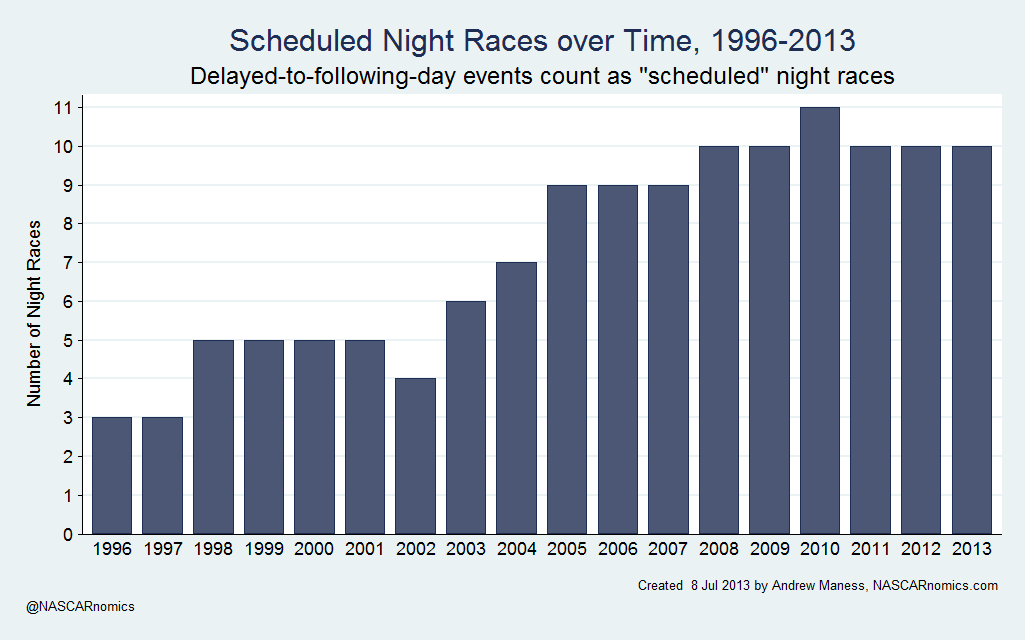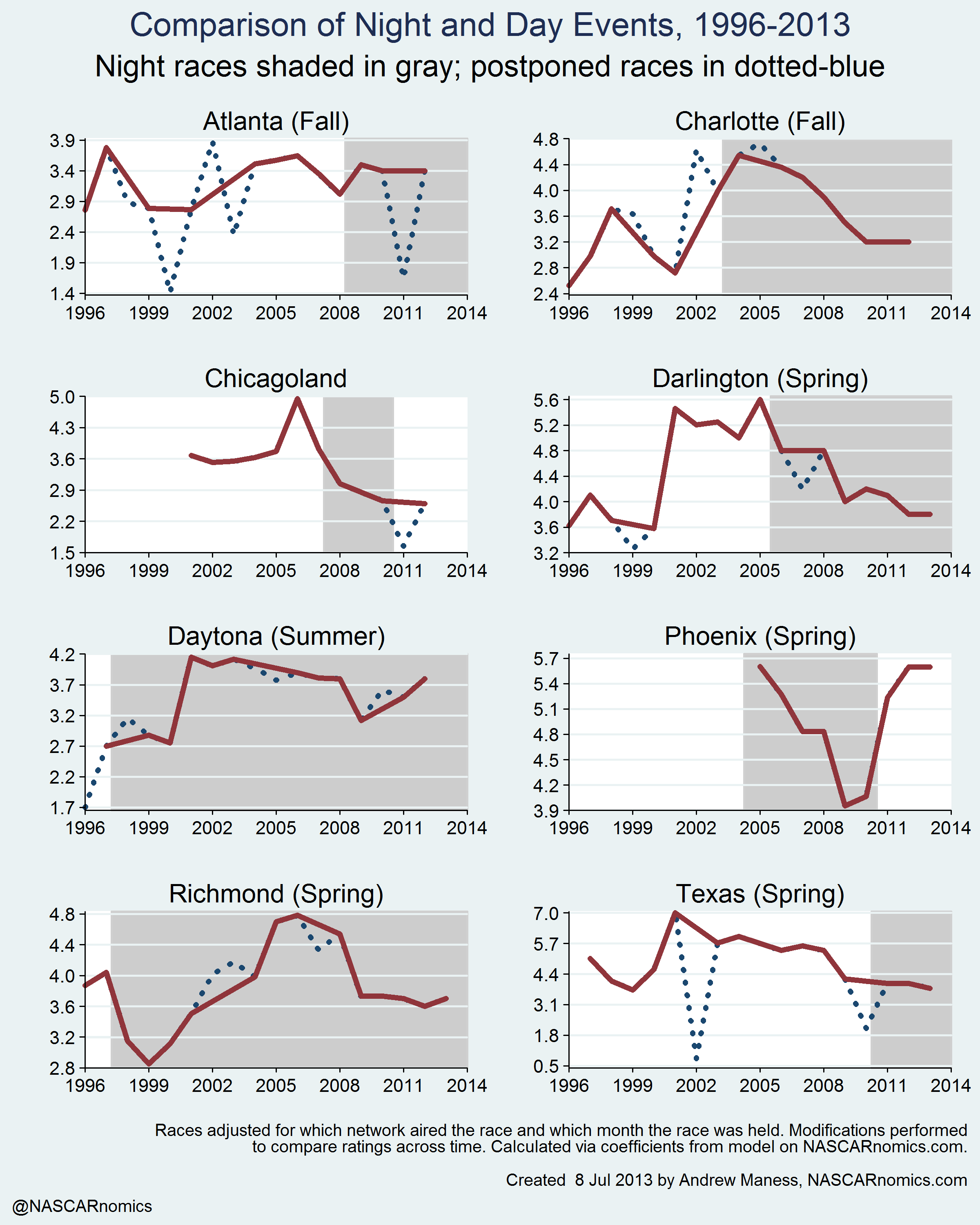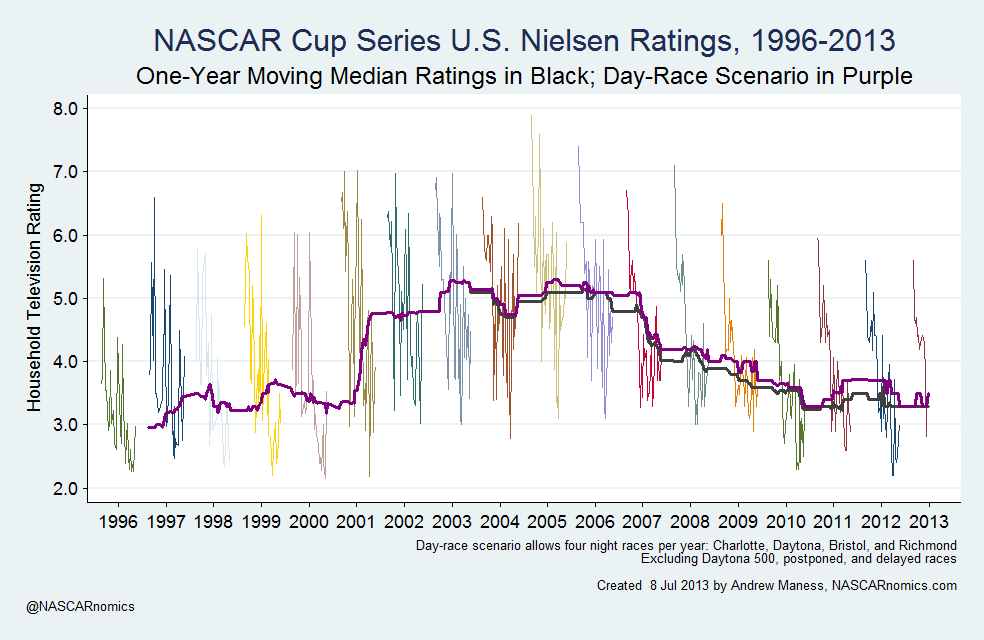On Night Racing…
Night racing is a motorsports staple in the United States. Regional short tracks host events on Friday and Saturday evenings in front of boisterous, loyal crowds as local legends and future stars strive for victory. Similar to other sports’ professional/amateur dichotomy, NASCAR’s top series held almost all of its races on Sunday afternoons for many years; that is, the series refrained from any overlap with local facilities’ events. The sanctioning body, however, noted the success of grassroots racing and applied more “night racing” to the Cup Series schedule in the 2000s. In recent years, more than one-third of the thirty-eight scheduled races occur “under-the-lights.” NASCAR’s overhaul of the schedule is reflected in the table below:
From 1996-2004, less than fourteen percent of races were run at night. That fraction has jumped to an astounding twenty-seven percent over the past nine seasons.
There are many benefits to moving an event to a Saturday evening. Those traveling to the racetrack may return home before the traditional work week begins. Drivers, crews, and teams spend a rare Sunday at home. Everybody at the track embraces cooler temperatures. But how do these events perform on television? The late Benny Parsons gave his opinion at the dawn of the night-racing craze in 2000:
Everybody is going out, taking the wife and going to a show, or maybe the diehards are going to the local track to see how the guys there are doing. … I’m paid by television and hope to continue to be paid by television for a long time. I think all you have to do is look at the ratings to see where the best deal is.
So was he correct? Watching an event on television offers a very low-cost alternative to making a trip to the racetrack, so it’s a good gauge for how popular NASCAR races are. (There are many other reasons for why NASCAR’s television ratings serve as a fantastic proxy for interest among the population that I outlined in a previous post.) Therefore, my question for this scheduling initiative is, “How has night-race proliferation affected NASCAR’s popularity?”
The Cup Series’ scheduled number of evening races jumps from three in 1996 (weekend stops at Charlotte, Bristol, and Richmond) to as many as eleven in 2010. After moving Phoenix’s first race of the year to a Sunday afternoon in 2011, NASCAR’s top series currently has ten night-time events scheduled annually:

There exists a strong negative correlation between NASCAR’s historical television ratings and the number of annual night races (that is, overall ratings decline as the number of night races increases). The Cup Series’ overall ratings has decreased since 2006, so it seems that night-time events may contribute to that steep decline.
But is the lack of interest in NASCAR all due to tripling the number of night races per season? I run a preliminary test by plotting the ratings of racetracks that have hosted events at night and during the day. Those locations provide a glimpse to how night racing affects television interest. I graph the eight facilities that have scheduled their specific events during Saturday nights or Sunday afternoons over the past eighteen years (Atlanta, Charlotte, Chicagoland, Darlington, Daytona, Phoenix, Richmond, and Texas). I adjust the ratings by network and by month to provide a meaningful comparison of how successful ratings have been for each race over time:

Races that are held at night are shaded in gray, while the day races have a blank background. I examine a few relationships:
- Many tracks suffer a hit in their household ratings when conducting evening races. Charlotte, Chicagoland, Darlington, and Richmond all decline when switching to night-time events. Phoenix’s spring race welcomed a nice uptick in viewership after moving its event to a Sunday afternoon.
- Two quad-ovals, Atlanta and Texas, don’t appear to be susceptible to any change when scheduling a night race. Atlanta remains at a consistent level, while Texas continues its decade-long downward trend.
- Daytona sees success on television since introducing its Saturday night summer race. This makes sense — the event was run on Saturday mornings in 1996 and 1997 as an attempt to beat the Florida heat and humidity.
So I’m closer to finding some results. That graph is very descriptive. The one thing that could explain many of those facilities’ declines, however, is the general drop in interest that NASCAR suffered from 2006 through 2010 — both for Sunday afternoon and Saturday night events. To find out what the real effect of night racing is, then, I hold constant several other race and television contract characteristics that might affect household ratings and execute my model: 
(You can view the model’s entire results here.)
Night racing doesn’t look too good from a television perspective. All other race characteristics (track type, television station, etc.) held equal, running an evening event erodes the audience by roughly 12%, according to the reported coefficient value [ -0.118 * 100 ]. For example, a race that draws a 4.0 during the day earns just a 3.5 at night [ (-0.118 * 4.0 ) + 4.0 ]. Obviously, exceptions such as the Daytona summer race exist (and what about that idea of running weeknight races?); but in general, the proliferation of night racing has a significantly negative effect on the interest-level of NASCAR.
Just to provide a visualization of night racing’s effect on NASCAR, I chart the usual historical look at television ratings. The purple line plots measured long-term ratings if NASCAR continued scheduling its three traditional night races, the Daytona night race, and no other Saturday night events:

NASCAR certainly could use more Sunday afternoon races to maintain higher ratings. And even though a massive decline in ratings would have occurred in the late 2000s, it might have been a little slower and softer than the one that happened in reality. With just three off-weeks in 2013, perhaps the sanctioning body prefers Saturday night races to ensure that teams can have a few extra Sundays at home. As with most scheduling constraints, it’s a balancing act. There are benefits to night racing in the Cup Series — more fans can travel to events, the weather is more manageable, and teams tend to enjoy it, — but the expense is that the normal television audience is doing something else on Saturday evenings.
Why do you think that night races don’t perform as well on television? Was ol’ B.P. right? Do people’s social lives take precedent on Saturday evenings? Why run these marquee Cup events in prime-time if they compete with local tracks’ schedules? Do you prefer Saturday night events over those on Sunday afternoons? And what about weeknight races, e.g. the 2014 Budweiser Duel at Daytona? Could those work? Feel free to contact me via e-mail, on Twitter, or on “Reddit” with your opinions. Here are links to each point of contact:
- You may contact me via e-mail at
- I hang out on Twitter and post some pretty cool graphs –
- Somebody posted NASCARnomics.com to Reddit; I answer questions on there, too
Thank you for reading. Please ask me all of the questions you have. I’ll do my best to answer them all.
Andrew